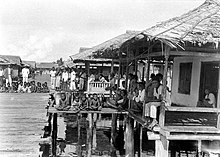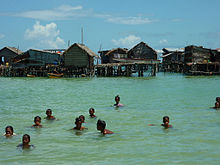സമ-ബജാവു
 West Coast Bajau women of Sabah in their traditional dress | |
| Total population | |
|---|---|
| 1.1 million worldwide | |
| Regions with significant populations | |
| ~470,000 | |
| ~436,672[1] | |
| 175,000[2] | |
| 12,000[3] | |
| Languages | |
| Sinama,[4] Bajau, Filipino, Malay/Indonesian | |
| Religion | |
| Sunni Islam (majority), Folk Islam, Animism, Christianity | |
| ബന്ധപ്പെട്ട വംശീയ ഗണങ്ങൾ | |
| Yakan, Iranun, Lumad Tausūg, other Moros, Filipinos Malays, Bugis, and other wider Austronesian peoples | |
തെക്കൻ ഫിലിപ്പൈൻസിൽനിന്നുദ്ഭവിച്ച ആസ്ട്രോനേഷ്യൻ വർഗ്ഗത്തിൽപ്പെട്ട ഗോത്രസമുദായമാണ് സമ-ബജാവു. Tസമ എന്നു സ്വയം വിളിക്കപ്പെടുന്നു. ബജാവു എന്നുമറിയപ്പെടുന്നു. (/ˈbɑːdʒaʊ, ˈbæ-//ˈbɑːdʒaʊ, ˈbæ-/. സമുദ്രവുമായി ബന്ധപ്പെട്ട ജീവിതമാണിവരുടേത്, പെരാഹു perahu (layag in Meranau), djenging, balutu, lepa, pilang, and vinta (or lepa-lepa)എന്നറിയപ്പെടുന്ന തടികൊണ്ടുണ്ടാക്കിയ വള്ളത്തിലാണിവർ കടലിലൂടെ സഞ്ചരിക്കുന്നത്. സബായ്ക്കടുത്തുള്ള Sabah ഈ വിഭാഗം ഗോത്രക്കാർ തങ്ങളുടെ കുതിരകളെ വളർത്തിവരുന്നു.
ഇന്തോനേഷ്യയുടെ കിഴക്കൻ പ്രദേശത്തും സെലെബിസിലും ഉത്തര പൂർവ്വ ബോർണ്ണിയോയിലും ഫിലിപ്പൈൻസിലെ മിന്ദനാവോയിലും സുലു ഉപദ്വീപിലും ഇവരെ കാണാനാകും .[5] ഫിലിപ്പൈൻസിൽ ഇവർക്കു സമരായ മോറോ ജനതയെപ്പോലെ ഇവർ ഒന്നിച്ചുകൂടി ഒരേ മതത്തിൽ വിശ്വസിക്കുന്നു. മിന്ദനാവോയിലെ സംഘർഷങ്ങൾ കാരണം സമ-ബജാവു ജനതയിലെ അനേകം പേർ കഴിഞ്ഞ 50 വർഷങ്ങളായി, അടുത്തുള്ള മലേഷ്യ, ഫിലിപ്പൈൻസിന്റെ വടക്കൻ ദ്വീപുകൾ എന്നിവിടങ്ങളിലേയ്ക്കു താമസം മാറ്റിയിട്ടുണ്ട്.[6] മലേഷ്യയിലെ സബാഹിലെ രണ്ടാമത്തെ ന്യൂനപക്ഷജനതയായി ഇവർ മാറിയിട്ടുണ്ട്.[7]

ചരിത്രവും ഉത്ഭവവും[തിരുത്തുക]

വാമൊഴി പാരമ്പര്യം[തിരുത്തുക]
സമ-ബജാവു ജനതയുടെ ഉത്ഭവത്തെപ്പറ്റിയുള്ള ആധുനിക ഗവേഷണഫലം[തിരുത്തുക]



ചരിത്രപരമായ തെളിവുകൾ[തിരുത്തുക]


ആധുനികരായ സമ-ബജാവു[തിരുത്തുക]






ഭാഷകൾ[തിരുത്തുക]
സംസ്കാരം[തിരുത്തുക]
ഭാഷ[തിരുത്തുക]

Boat-dwelling[തിരുത്തുക]


സംഗീതം, നൃത്തം, കല[തിരുത്തുക]

കുതിരകളോടൊത്ത സംസ്കാരം[തിരുത്തുക]

Society[തിരുത്തുക]

ജനപ്രിയസംസ്കാരം[തിരുത്തുക]

അറിയപ്പെടുന്ന സമ-ബജാവു വംശജർ[തിരുത്തുക]
കലാകാരർ[തിരുത്തുക]
കായികരംഗത്തെ സമ-ബജാവു[തിരുത്തുക]
ഇതും കാണൂ[തിരുത്തുക]
- Lumad
- Gaya Island
- Orang Laut
- Sama–Bajaw languages
Notes[തിരുത്തുക]
References[തിരുത്തുക]
- ↑ "Total population by ethnic group, administrative district and state, Malaysia" (PDF). Department of Statistics, Malaysia. 2010. pp. 369/1. Archived from the original (PDF) on 27 February 2012. Retrieved 12 October 2014.
- ↑ Project, Joshua. "Bajau in Indonesia". joshuaproject.net.
- ↑ Project, Joshua. "Bajau, West Coast in Brunei". joshuaproject.net.
- ↑ "What Language do the Badjao Speak?". Kauman Sama Online. Sinama.org. Retrieved 23 February 2013.
- ↑ (Thesis).
{{cite thesis}}: Missing or empty|title=(help)ശൂന്യമായതോ ഇല്ലാത്തതോ ആയ|title=(സഹായം) - ↑ "The Bajau, the Badjao, the Samals, and the Sama People". Retrieved 3 December 2012.
- ↑ "Sabah's People and History". Sabah State Government. Archived from the original on 2016-06-02. Retrieved 25 March 2015.
The Kadazan-Dusun is the largest ethnic group in Sabah that makes up almost 30% of the population. The Bajaus, or also known as "Cowboys of the East", and Muruts, the hill people and head hunters in the past, are the second and third largest ethnic group in Sabah respectively. Other indigenous tribes include the Bisaya, Brunei Malay, Bugis, Kedayan, Lotud, Ludayeh, Rungus, Suluk, Minokok, Bonggi, the Ida'an, and many more. In addition to that, the Chinese makes up the main non-indigenous group of the population.
- ↑ "Masjid An-Nur Tuaran". Islamic Tourism Centre of Malaysia. Archived from the original on 12 August 2016. Retrieved 12 August 2016.
- ↑ Ian MacDonald. "Sabah (Malaysia)". CRW Flags. Archived from the original on 25 May 2016. Retrieved 25 May 2016.
